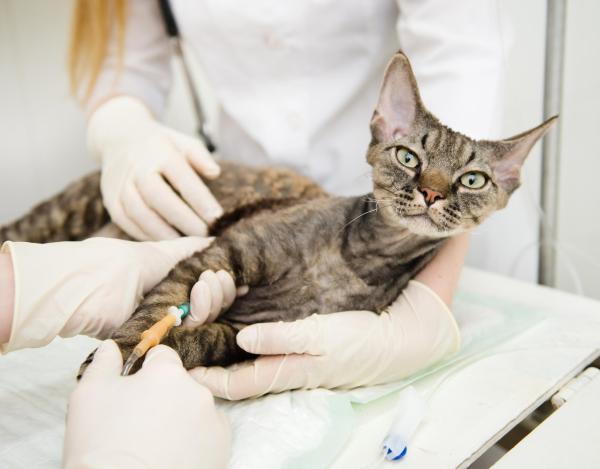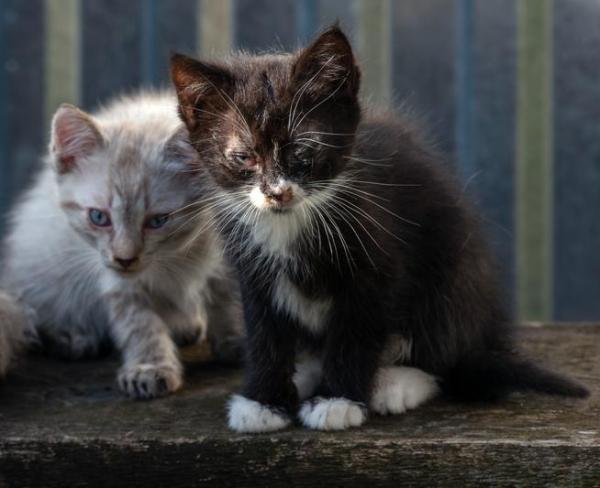
Like humans, cats can suffer from infections caused by viruses. Viruses invade living, normal cells and use them to multiply and produce other viruses like themselves. This can kill, damage or mutate cells and make your cat sick. Different viruses attack different cells in the cat's body, such as the liver, respiratory tract, or blood. For most viral infections, treatments can only help with the symptoms while waiting for the immune system to fight the virus.
The following AnimalWised article describes the most common viral diseases in cats, their symptoms, and treatment.
Feline infectious peritonitis (FIP)
Feline infectious peritonitis is a fatal disease of cats caused by feline coronavirus. Feline coronavirus infection is very common in cats, but in most cases causes no problems other than mild, self-limiting diarrhea. In rare cases, the virus mutates (changes) within an infected cat, and it is this mutated form that causes the disease called FIP.
Although the exact cause of the viral mutation is not known, it is known that several factors appear to influence the mutation. Most cases of FIP occur in young cats. An inadequate immune response combined with other stressors, such as a move, neutralization surgery, vaccination, or the presence of concurrent disease, seem to make young cats more susceptible to FIP.
The clinical manifestations of FIP are very diverse, so there are no clinical signs that are pathognomonic for the disease. The most classic form of the disease, called "wet FIP", is characterized by the accumulation of yellowish fluid in the abdominal cavity (causing abdominal distention) and/or the thoracic cavity (pleural effusion, causing respiratory distress).
Treatment of feline infectious peritonitis
Once the clinical signs of FIP appear, it is an incurable and fatal disease. Treatment is aimed at alleviating symptoms and is based on anti-inflammatory drugs and appetite stimulants.
Feline respiratory disease complex
Cat flu is a very common feline disease that can be chronic. Cat flu is more common in environments where large numbers of cats are present, such as kennels, shelters, and feral cat colonies, although domestic cats can also contract it.
Most at risk are unvaccinated cats, kittens, old cats, and cats that are immunosuppressed for any reason. When a cat dies from influenza, it is usually due to secondary infections (caused by bacteria associated with feline influenza), lack of food, and dehydration.
Symptoms of feline influenza are often caused by infection with one or both of the feline influenza viruses: feline herpesvirus (formerly known as feline rhinotracheitis virus) and feline calicivirus. Symptoms include sneezing, nasal discharge, conjunctivitis, eye discharge, loss of appetite, fever, and depression. Occasionally, corneal ulcers and excessive drooling from oral ulcers may also be seen in affected cats.
Treatment of cat flu
Unfortunately, there are no medications that can kill these viruses, so the goal of treatment is to support the animal for the duration of the disease. This includes antibiotics to fight secondary infections that can lead to death, as well as medications to stop nasal discharge and help the animal breathe without difficulty.
Dehydrated cats also require intravenous fluid therapy via catheters. Palliative care is also essential. Heavy discharge from the eyes and nose should be continuously removed gently with a moistened cotton swab, and the cat should always be kept in a warm, comfortable environment.

Feline panleukopenia
Feline panleukopenia (FP) is a highly contagious viral disease of the cat caused by the feline parvovirus. The disease is also known as feline distemper or feline parvo. Because the virus FP is found everywhere in the environment, virtually all kittens and cats are exposed to the virus at some point in their lives. Although cats of any age can be infected with the feline parvovirus that causes FP, young kittens, sick cats and unvaccinated cats are most susceptible.
The FP virus attacks the intestines, the bone marrow and lymph nodes, resulting in a deficiency of all types of white blood cells (panleukopenia) and red blood cells (anemia). Symptoms include general depression, loss of appetite, high fevers, lethargy, vomiting, diarrhea, nasal discharge, and dehydration.
In the past, feline panleukopenia was one of the leading causes of death in cats. Luckly, today, it is a rare disease, thanks to the availability and use of very effective vaccines.
Treatment of feline panleukopenia
The likelihood that infected kittens less than eight weeks old will recover from FP is low. Older cats have a greater chance of survival if they receive appropriate treatment early. Because there are no medications that can kill the virus, intensive care and treatment are critical to support the cat's health with medications and fluids until their own body and immune system can fight the virus.
Treatment focuses on correcting dehydration, providing nutrients and preventing secondary infections.

Feline leukemia virus (FeLV)
Feline leukemia virus is common in cats worldwide and causes severe depression of the immune system in permanently infected cats. Any cat can become infected with the virus, but the risk of infection varies greatly depending on the cat's age, habits, general health, and the environment in which it lives.
Chronic FeLV infection may result in fever and lethargy, loss of appetite, deterioration of the coat, swollen lymph nodes, pale gums and other mucous membranes caused by anemia, skin infections, or respiratory infections.
Anemia occurs in 25% of infected cats. Cancer occurs in 15% of infected cats. The most common form is lymphoma, a cancer of the lymphocytes (a type of white blood cell) that causes tumors or leukemia.
FeLV can be transmitted through mutual grooming (including from mother to kittens) or through bite wounds. The virus is present in body fluids, especially saliva, urine, and feces.
Treatment of feline leukemia
Treatment should be aimed only at maintaining the quality of life and controlling the effects of the infection. Feline leukemia is a very serious chronic disease, but like many other chronic diseases, it is manageable in the long run. Infected cats require some extra care, but with proper care can have a good quality of life.
If a cat tests positive for feline leukemia, the prognosis is not good. Between 80% and 90% of infected cats die within 6 months to 3 years of diagnosis because the problems associated with the disease are usually severe.
The best prevention against leukemia is to avoid contact of the cat with other infected individuals and to vaccinate your cat.
If you want to learn more about this disease, continue reading this other article, where we explain in more detail what feline leukemia is.

Feline immunodeficiency virus (FIV)
Feline immunodeficiency virus (FIV) infection is one of the most common diseases in stray cats. Clinical signs in these cats are similar to those in humans with AIDS, a disease caused by human immunodeficiency virus (HIV) infection. However, the viruses are species-specific, i.e., FIV infects only cats and HIV infects only humans.
The immunodeficiency virus attacks the cells of the immune system (white blood cells or leukocytes) by destroying or damaging them. This leads to a gradual deterioration of the cat's immune function.
In the early stages of infection, there may be no obvious signs of disease, and the cat may appear perfectly healthy. However, as months or even years pass, more signs appear due to the direct effect of the virus and the weakening of the immune system. In addition, the cat's inability to fight off other infections makes it more susceptible to other diseases or secondary infections. These diseases can take different forms and therefore the clinical signs can be very variable.
The most common form of transmission of the virus is biting during a fight. For this reason, unneutered males are at higher risk of infection and the prevalence increases in cats with access to the outdoors, stray and ownerless cats.
Treatment of feline immunodeficiency (FIV)
To date, there is no treatment that leads to remission of an established infection. The main goal of treating an FIV-infected cat is to stabilize the patient and maintain a good quality of life.
Some antiviral drugs used in HIV patients (e.g., azidothymidine, AZT), although not approved for treatment of cats, have been shown to be effective in some infected cats.
Prompt and effective treatment of secondary infections is essential in a sick FIV-positive cat. Because these cats are immunosuppressed, prolonged antibiotic treatment is often required.
If you want to learn more about this disease, continue reading this other article, where we explain in more detail what Feline Immunodeficiency Virus is.

Feline viral rhinotracheitis (FVR)
Feline viral rhinotracheitis (FVR) is a common respiratory disease in cats because it is highly contagious. It is caused by two main viruses, Feline Herpesvirus and Feline Calicivirus. It leads to complications in the health of the animal and can even leave serious sequelae or even lead to death if not treated in time.
This disease is very contagious as it is transmitted through contact with secretions such as tears, nasal mucus or sneezing of infected cats.
The most common symptoms are fever, loss of appetite, lacrimation, mouth ulcers, permanent sinus congestion, excessive nasal discharge and lacrimation or chronic eye infections.
If you notice any abnormalities in your cat's behavior, it is important to see a veterinarian who can thoroughly diagnose your cat's health and rule out the presence of feline rhinotracheitis.
Treatment of feline viral rhinotracheitis
There is currently no curative treatment for feline rhinotracheitis. Treatments focus on maintaining good general health of the cat, treating secondary bacterial infections, and minimizing clinical signs.
It is essential to keep the cat well hydrated (with wet food, water available, or fluid therapy in more severe cases), well nourished, and proper cleansing of nasal and ocular secretions. In addition, it may be necessary to administer various types of medications to control symptoms (eye drops, nebulization, etc.) to provide good overall care that will promote a satisfactory recovery.
If you want to learn more about this disease, continue reading this other article, where we explain in more detail what Feline Viral Rhinotracheitis (FVR) is.

This article is purely informative. AnimalWised does not have the authority to prescribe any veterinary treatment or create a diagnosis. We invite you to take your pet to the veterinarian if they are suffering from any condition or pain.
If you want to read similar articles to Most Common Viral Diseases in Cats, we recommend you visit our Viral diseases category.
- Massitel, IL. (2021). Feline infectious peritonitis: review . PubVet, v.15, n.1. Available at file:///C:/Users/carlamoreira/Downloads/peritonite-infecciosa-felina-revisatil.pdf. Accessed on 08/10/2022.
- Daniel, AGT (2015). Diseases of the anterior respiratory tract in cats . Pet Newsletter, Agener União, v. 3. Available at: https://s3-sa-east-1.amazonaws.com/vetsmart-contents/Documents/DC/AgenerUniao/Doencas_Trato_Respiratorio_Anterior_Gatos.pdf. Accessed on 08/10/2022.
- Latif, HA (2009). Feline infectious panleukopenia . Rev. Scientific Electronics Med. Veterinary, no. 12. Available at: http://www.faef.revista.inf.br/imagens_arquivos/arquivos_destaque/M740Ww1C8nWhuyp_2013-6-21-12-3-43.pdf. Accessed on 08/10/2022.